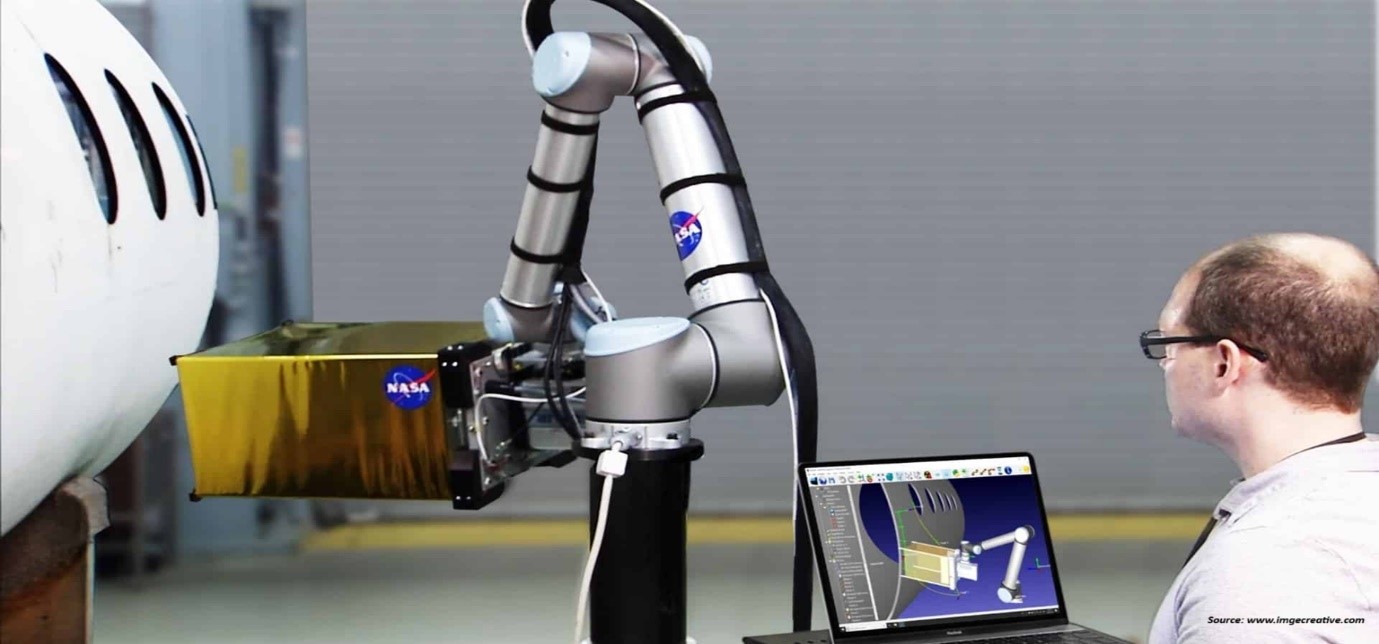
Warehouse Control System Market by Component (Hardware, Software), by Operation (Goods-to-person (GTPs), Autonomous Mobile Robots, Autonomous Ground Vehicles, AS/RS Cranes, Conveyance, Print and Apply, Others), by Deployment Mode (On-Premise, Cloud Based), by Organization Size (Large Enterprises, Small and Medium Enterprises) – Global Opportunity Analysis and Industry Forecast 2024-2030
US Tariff Impact on Warehouse Control System Market
Trump Tariffs Are Reshaping Global Business
Warehouse Control System Market Overview
The global Warehouse Control System Market size was valued at USD 3.55 billion in 2023 and is predicted to reach USD 10.12 billion by 2030 with a CAGR of 16.2% from 2024-2030.
The warehouse control system market is software application that integrates with the warehouse management system (WMS) to manage and automate tasks within a warehouse. The primary role of a WCS is to coordinate the movement of goods throughout the warehouse, providing real-time instructions to both operators and automated systems.
The WCS is created to easily blend with various automated systems, including simple conveyors and advanced solutions such as sorters and automated storage and retrieval systems. With the implementation of a strong warehouse control system, companies are enhancing inventory management, order fulfilment, lower labor expenses, and boost productivity. This ultimately results in improved customer satisfaction, higher market presence, and better financial results.
Market Dynamics and Trends
The rapid market growth of e-commerce and the adoption of omnichannel retail strategies increased the demand for efficient and flexible warehouse operations. WCS plays a crucial role in optimizing order fulfillment processes and adapting to the dynamic nature of online retail. According to the International Trade Administration, the global B2C e-commerce revenue is expected to grow at USD 5.5 trillion by 2027 as compared with 2023 with a revenue of USD 3.6 trillion.
Also, the growing trend towards warehouse automation, including the integration of robotics and autonomous systems, is a key driving factor for the warehouse control system (WCS) industry. This facilitates the seamless interaction and coordination of various automated components, ensuring efficient workflows and maximizing the benefits of robotics in enhancing warehouse operations. In March 2024, Korber Supply Chain launched the Unified Control System (UCS) platform that effectively manages Autonomous Mobile Robots (AMRs) and Automated Guided Vehicles (AGVs) by orchestrating their operations within the warehouse environment. This utilizes warehouse management system (WMS) data to streamline inbound and outbound workflows, resulting in improved throughput and reduced complexity in logistics operations. However, the high upfront cost of implementing a comprehensive WCS which involves significant upfront costs for software and integration is hindering the market expansion.
On the contrary, the integration of the Internet of Things (IoT) and artificial Intelligence (AI) in warehouse control systems (WCS) presents numerous future opportunities that significantly enhance warehouse operations and efficiency. This leads to improved asset management, safety, and customer satisfaction while optimizing supply chain coordination and sustainability. For instance, in March 2024, Dexory launched its AI-powered logistics engine aimed at optimizing warehouse operations and enhancing efficiency in the global logistics sector. This technology utilizes autonomous robots to gather and analyze vast amounts of data daily, allowing for real-time insights and predictive analytics.
Market Segmentation and Scope of Study
The warehouse control system market report is divided on the basis of operation, deployment mode, organization size, industry vertical and region. On the basis of operation, the market is categorized into goods-to-person, AMRs and AGVs, AS/RS cranes, conveyance, print and apply, and others. On the basis of deployment mode, the market is segmented into on-premise and cloud based. On the basis of organization size, the market is classified into large enterprises, and small and medium enterprises. On the basis of industry vertical, the market is bifurcated into e-commerce, retail and consumers goods, healthcare and pharmaceuticals, transportation and logistics, manufacturing, and other industries. Regional breakdown and analysis of each of the aforesaid segments includes regions comprising of North America, Europe, Asia-Pacific, and RoW
Geographical Analysis
North America holds the dominating share of warehouse control system (WCS) market trends at present and is expected to continue its dominance throughout the forecast period. This is attributed to the rising labor shortages in the warehousing industry, which are driving the need for warehouse control systems that optimize labor usage, reduce dependency on human workers, and enhance overall efficiency through automation and advanced technology. These systems are becoming increasingly important as warehouses struggle to fill key positions and meet rising customer demands.
As an example, Manpower Group report highlights that the U.S. accounted for 70% of labor shortage for the year 2024, accompanied with Canada for 80% in the following year. This significant labor shortage underscores the growing acceptance of WCS to optimize operations and enhance efficiency through automation.
Also, the advent of technological advancements, including RFID and automation integration into warehouse control systems is driving the warehouse control system market expansion. These innovations enhance WMS capabilities by providing real-time tracking, improving accuracy in inventory management, and increasing overall operational efficiency.
For instance, in January 2024, Sensormatic Solutions and Allbirds collaborated to enhance inventory accuracy and supply chain management. This collaboration aims to leverage RFID technology to enhance supply chain management, track item-level inventory, and improve the overall shopper experience.
On the other hand, Asia-Pacific is considered fastest growing region in the WCS software industry owing to the increasing expansion of e-commerce which led to increased demand for efficient warehouse operations According to a report published on International Trade Administration by eMarketer, the online retail transaction in China reached at USD 2.29 trillion in 2020 and is expected to reach USD 3.56 trillion by 2024.
Moreover, the growing need for automation in distribution centers and warehouses drives the market demand for WCS in countries such as Japan, China and others. Companies are increasingly adopting WCS to enhance operational efficiency, accuracy in order fulfilment, and inventory management that are crucial for meeting customer demands in a competitive market. For instance, in March 2024, Bar Code India (BCI) launched a new software solution aimed at enhancing warehouse control and management process. These solutions are designed to streamline operations, improve inventory tracking, and optimize logistics processes. This initiative aims to utilize technology in the supply chain sector to enhance efficiency and lower operational costs for warehouse services.
Competitive Landscape
Various key players in the warehouse control system industry includes Korber AG, Blue Yonder Inc, Conveyco, Dematic, Siemens AG, Swisslog Holding AG, Oracle Corporation, Royal 4 Systems, ASC Software, Kapelou LLC, Falcon Autotech, SSI SCHAEFER AG in, Russell Conveyor & Equipment, Grenzebach Group, Quality Material Handling Inc, and Others. These market players are opting various strategies such as partnership to maintain their dominance in the global market.
For instance, in March 2024, Dematic partnered with PepsiCo to implement a high-capacity logistics automation system aiming to enhance production and logistics efficiency. The company integrated an Automated Storage and Retrieval System (AS/RS) solution from Dematic, which includes high-density storage, pallet conveyors, Rail Guided Vehicles (RGVs), and Warehouse Control System (WCS) software.
For instance, in November 2023, Unicommerce and Ezmall partnered to streamline its supply chain operations. The partnership aims to better serve Ezmall’s fast-growing consumer base owing to its aggressive plan of launching more brands in the coming months.
Moreover, in February 2022, Vinculum and Shadowfax Technologies partnered to venture into the warehouse management system (WMS) to offer end-to-end (E2E) services across multiple industry segments such as e-commerce, apparel, consumer electronics, and auto. The integrated software from Vinculum will enable Shadowfax to enhance its fulfillment speed, provide real-time inventory monitoring, and focus on customer satisfaction.
Key Benefits
-
The report provides quantitative analysis and estimations of the warehouse control system market from 2024 to 2030, which assists in identifying the prevailing market opportunities.
-
The study comprises a deep-dive analysis of the warehouse control system market including the current and future trends to depict prevalent investment pockets in the market.
-
Information related to key drivers, restraints, and opportunities and their impact on the warehouse control system market is provided in the report.
-
Competitive analysis of the players, along with their market share is provided in the report.
-
SWOT analysis and Porters Five Forces model is elaborated in the study.
-
Value chain analysis in the market study provides a clear picture of roles of stakeholders.
Warehouse Control System Market Key Segments
By Component
-
Hardware
-
Software
By Operation
-
Goods-to-person (GTPs)
-
Autonomous Mobile Robots
-
Autonomous Ground Vehicles
-
AS/RS Cranes
-
Conveyance
-
Print and Apply
-
Others
By Deployment Mode
-
On-Premise
-
Cloud Based
By Organization Size
-
Large Enterprises
-
Small and Medium Enterprises
By Industry Vertical
-
E-Commerce
-
Retail and Consumers Goods
-
Healthcare and Pharmaceuticals
-
Transportation and Logistics
-
Manufacturing
-
Other Industries
By Region
-
North America
-
The U.S.
-
Canada
-
Mexico
-
-
Europe
-
The UK
-
Germany
-
France
-
Italy
-
Spain
-
Denmark
-
Netherlands
-
Finland
-
Sweden
-
Norway
-
Russia
-
Rest of Europe
-
-
Asia-Pacific
-
China
-
Japan
-
India
-
South Korea
-
Australia
-
Indonesia
-
Singapore
-
Taiwan
-
Thailand
-
Rest of Asia-Pacific
-
-
Rest of the World
-
Latin America
-
Middle East
-
Africa
-
REPORT SCOPE AND SEGMENTATION:
|
Parameters |
Details |
|
Market Size in 2023 |
USD 3.55 Billion |
|
Revenue Forecast in 2030 |
USD 10.12 Billion |
|
Growth Rate |
CAGR of 16.2% from 2024 to 2030 |
|
Analysis Period |
2023–2030 |
|
Base Year Considered |
2023 |
|
Forecast Period |
2024–2030 |
|
Market Size Estimation |
Billion (USD) |
|
Growth Factors |
|
|
Countries Covered |
28 |
|
Companies Profiled |
15 |
|
Market Share |
Available for 10 companies |
|
Customization Scope |
Free customization (equivalent to up to 80 working hours of analysts) after purchase. Addition or alteration to country, regional, and segment scope. |
|
Pricing and Purchase Options |
Avail customized purchase options to meet your exact research needs. |
KEY PLAYERS
-
Korber AG
-
Blue Yonder Inc
-
Conveyco
-
Dematic
-
Siemens AG
-
Swisslog Holding AG
-
Oracle Corporation
-
Royal 4 Systems
-
ASC Software
-
Kapelou LLC
-
Falcon Autotech
-
SSI SCHAEFER AG in
-
Russell Conveyor & Equipment
-
Grenzebach Group
-
Quality Material Handling Inc

















 Speak to Our Analyst
Speak to Our Analyst





















